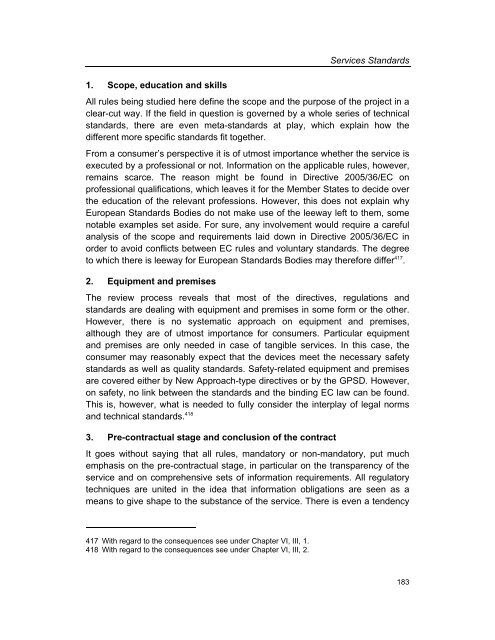Services Standards: Defining the Core Consumer Elements ... - ANEC
Services Standards: Defining the Core Consumer Elements ... - ANEC
Services Standards: Defining the Core Consumer Elements ... - ANEC
You also want an ePaper? Increase the reach of your titles
YUMPU automatically turns print PDFs into web optimized ePapers that Google loves.
1. Scope, education and skills<br />
<strong>Services</strong> <strong>Standards</strong><br />
All rules being studied here define <strong>the</strong> scope and <strong>the</strong> purpose of <strong>the</strong> project in a<br />
clear-cut way. If <strong>the</strong> field in question is governed by a whole series of technical<br />
standards, <strong>the</strong>re are even meta-standards at play, which explain how <strong>the</strong><br />
different more specific standards fit toge<strong>the</strong>r.<br />
From a consumer’s perspective it is of utmost importance whe<strong>the</strong>r <strong>the</strong> service is<br />
executed by a professional or not. Information on <strong>the</strong> applicable rules, however,<br />
remains scarce. The reason might be found in Directive 2005/36/EC on<br />
professional qualifications, which leaves it for <strong>the</strong> Member States to decide over<br />
<strong>the</strong> education of <strong>the</strong> relevant professions. However, this does not explain why<br />
European <strong>Standards</strong> Bodies do not make use of <strong>the</strong> leeway left to <strong>the</strong>m, some<br />
notable examples set aside. For sure, any involvement would require a careful<br />
analysis of <strong>the</strong> scope and requirements laid down in Directive 2005/36/EC in<br />
order to avoid conflicts between EC rules and voluntary standards. The degree<br />
to which <strong>the</strong>re is leeway for European <strong>Standards</strong> Bodies may <strong>the</strong>refore differ 417 .<br />
2. Equipment and premises<br />
The review process reveals that most of <strong>the</strong> directives, regulations and<br />
standards are dealing with equipment and premises in some form or <strong>the</strong> o<strong>the</strong>r.<br />
However, <strong>the</strong>re is no systematic approach on equipment and premises,<br />
although <strong>the</strong>y are of utmost importance for consumers. Particular equipment<br />
and premises are only needed in case of tangible services. In this case, <strong>the</strong><br />
consumer may reasonably expect that <strong>the</strong> devices meet <strong>the</strong> necessary safety<br />
standards as well as quality standards. Safety-related equipment and premises<br />
are covered ei<strong>the</strong>r by New Approach-type directives or by <strong>the</strong> GPSD. However,<br />
on safety, no link between <strong>the</strong> standards and <strong>the</strong> binding EC law can be found.<br />
This is, however, what is needed to fully consider <strong>the</strong> interplay of legal norms<br />
and technical standards. 418<br />
3. Pre-contractual stage and conclusion of <strong>the</strong> contract<br />
It goes without saying that all rules, mandatory or non-mandatory, put much<br />
emphasis on <strong>the</strong> pre-contractual stage, in particular on <strong>the</strong> transparency of <strong>the</strong><br />
service and on comprehensive sets of information requirements. All regulatory<br />
techniques are united in <strong>the</strong> idea that information obligations are seen as a<br />
means to give shape to <strong>the</strong> substance of <strong>the</strong> service. There is even a tendency<br />
417 With regard to <strong>the</strong> consequences see under Chapter VI, III, 1.<br />
418 With regard to <strong>the</strong> consequences see under Chapter VI, III, 2.<br />
183
















